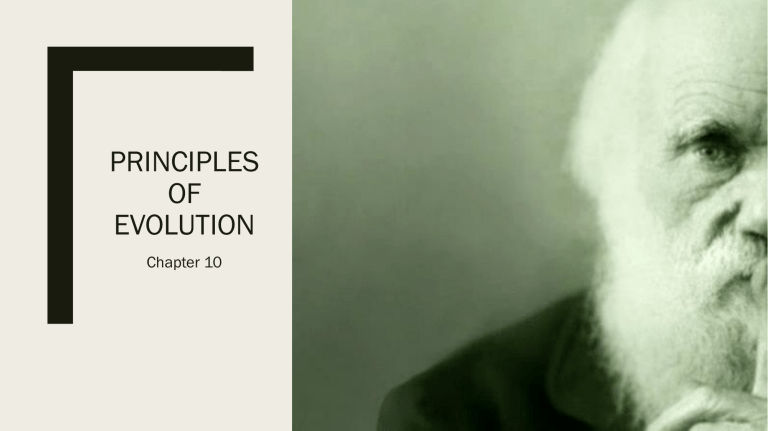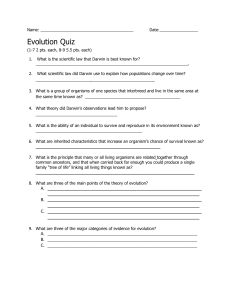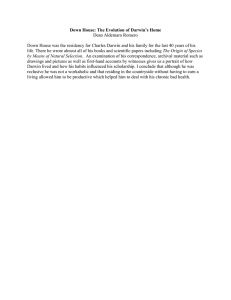
PRINCIPLES OF EVOLUTION Chapter 10 Contents ■ 10.1 Early ideas about evolution ■ 10.2 Darwin’s observations ■ 10.3 Theory of Natural Selection ■ 10.4 Evidence of Evolution ■ 10.5 Evolutionary Biology Today Chapter 10 Section 1 EARLY IDEAS ABOUT EVOLUTION There were theories of biological and geological change before Darwin Main Ideas Vocabulary ■ Early Scientists proposed ideas about Evolution ■ Evolution ■ Theories of geological change set the stage for Darwin’s theory ■ Species ■ Fossil ■ Catastrophism ■ Gradualism ■ Uniformitarianism EARLY SCIENTISTS PROPOSED IDEAS ABOUT EVOLUTION EVOLUTION the process of biological change by which descendants come to differ from their ancestors Early Naturalists – Carolus Linnaeus ■ Proposed a new system of organization for plants and animals ■ System was organized on the similarities of organisms ■ This system is still in use today and reflects evolutionary relationships 1735 ■ SPECIES = a group of organisms so similar to one another that they can reproduce and have fertile offspring. Early Naturalists – Georges Buffon 1749 ■ Discussed important ideas about: – Relationships among organisms – Sources of biological variation – The possibility of evolution ■ Proposed that species shared ancestors instead of arising separately ■ Rejected the idea popular at the time that the Earth was only 6000 years old ■ He suggested Earth was much older Early Naturalists – Erasmus Darwin ■ Charles Darwin’s grandfather ■ Considered how organisms could evolve through mechanisms such as competition ■ Proposed that all living things were descended from a common ancestor 1795 ■ Thought that more complex life arose from less complex forms Early Naturalists – Jean-Baptiste Lamarck ■ Proposed that all organisms evolved toward complexity ■ Thought the environment caused organisms’ behavior to change 1809 ■ Their organs would become larger or smaller due to use or disuse ■ Inheritance of acquired characteristics ■ Famous example of giraffes Lamarck’s Giraffes – Inheritance of acquired characteristics ■ giraffe necks become longer as the animals try to stretch their necks to reach food. ■ The longer necks acquired in this way would then be passed on to their offspring ■ We now know that this idea is WRONG! However, Darwin was influenced by Lamarck’s ideas that: • physical characteristics could be inherited • Changes in species were influenced by the environment THEORIES OF GEOLOGICAL CHANGE SET THE STAGE FOR DARWIN’S THEORY Catastrophism – Georges Cuvier Early 1800s ■ Interested in fossils: traces of organisms that existed in the past ■ Did not think that species could change since God created them ■ Appearance of new species resulted from catastrophic events such as floods and volcanoes Gradualism Late 1700s James Hutton ■ Proposed that changes in landforms resulted from slow changes over a long period of time ■ Processes like a river cutting through rock to create a canyon take place slowly and gradually ■ The term gradualism is often used now to mean the gradual development of a species through evolution. Uniformitarianism Charles Lyell 1830s ■ The geological processes that shape the Earth are uniform through time. ■ ”The present is the key to the past” ■ The small, slow processes occurring now were the same in the past ■ This idea replaced catastrophism as the favored theory of geological change ■ Lyell’s ideas greatly influenced Charles Darwin ■ Uniformitarianism is accepted in modern geology Chapter 10 Section 2 DARWIN’S OBSERVATIONS Darwin’s voyage provide insights into evolution Main Ideas Vocabulary ■ Darwin observed differences among island species ■ Variation ■ Darwin observed fossil and geological evidence supporting an ancient Earth ■ Adaptation DARWIN OBSERVED DIFFERENCES AMONG ISLAND SPECIES Darwin’s Voyage ■ Darwin set sail in 1831 on the ship HMS Beagle ■ 5-year journey ■ Went to South America, Africa, and the South Pacific Islands ■ During the voyage he read Lyell’s book Principles of Geology ■ Darwin observed living things, geological formations, and fossils across the world ■ He saw a lot of VARIATION in organisms Variation ■ The difference in the physical traits of an individual from those of other individuals ■ Interspecies Variation: variation among members of different species ■ Intraspecies Variation: variation among members of the same species Darwin’s Observations in South America ■ Darwin saw that the species on one island looked different from the species on other islands ■ Many species on islands looked different from those on the mainland ■ His observations of organism in Galapagos Islands were key to the development of his theory Darwin’s Observations: Galapagos Tortoises ■ Some variations seem wellsuited to the environments and diets of the animals ■ Saddle-backed tortoises have a high shell edge allowing them to stretch their long necks to reach the tall plants on their island ■ Domed tortoises have short necks and legs. The islands they live on have low vegetation Darwin’s Observations: Finches ■ Finches with strong thick beaks lived in areas with large hard-shell nuts ■ Finches with delicate pointy beaks lived on islands where fruits and insects were available. Adaptations ■ From his observations Darwin developed the idea of an ADAPTATION ■ Adaptation = a feature that allows an organism to better survive in its environment DARWIN OBSERVED FOSSIL AND GEOLOGICAL EVIDENCE SUPPORTING AN ANCIENT EARTH Darwin found fossil evidence of huge animals ■ Glyptodon – giant armadillo ■ Looked like modern living species ■ Suggested that modern animals might be related to fossil forms ■ Suggests Earth must be very old for there to be time for this change Darwin found fossil shells on the tops of high mountains ■ He experienced an earthquake that lifted a section of underwater rock eight feet above the ocean overnight ■ He saw that this supported Lyell’s ideas about small processes that can add up to big change over time ■ An ancient Earth and slow gradual change could also explain how species evolved


